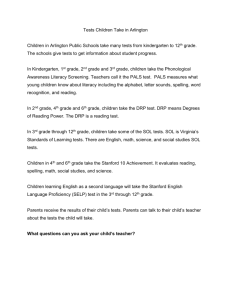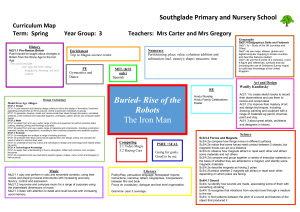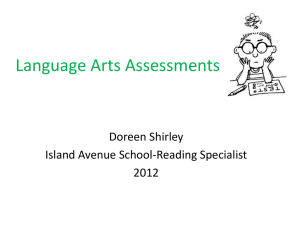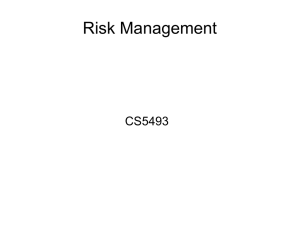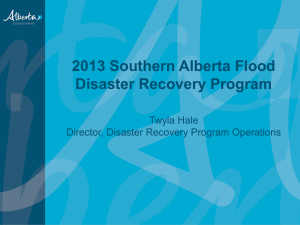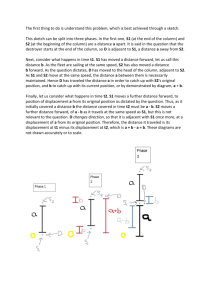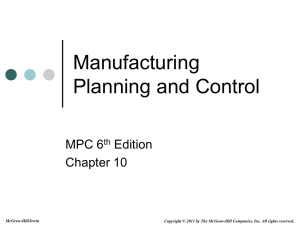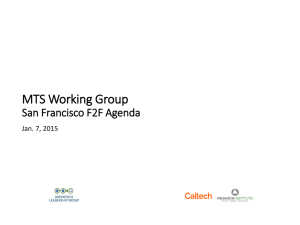guidelines for preparation of final reports and documents
advertisement
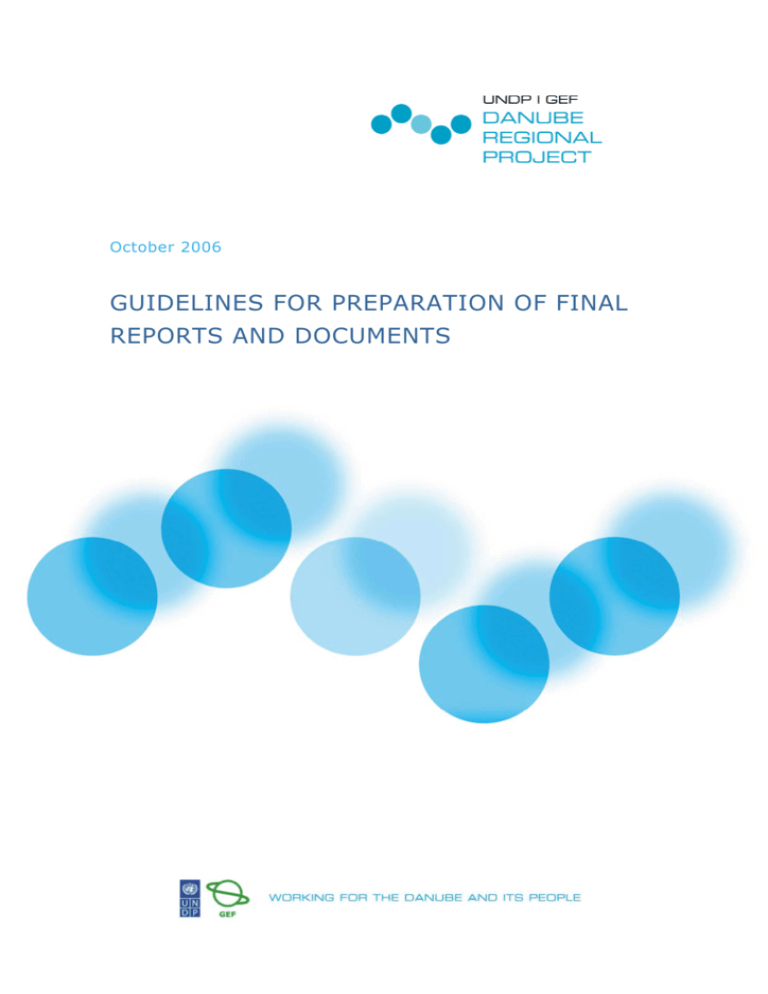
October 2006 GUIDELINES FOR PREPARATION OF FINAL REPORTS AND DOCUMENTS AUTHORS PREPARED BY: UNDP/GEF Danube Regional Project Agentur Sieben AUTHORS: Marcella Fabianova Peter Whalley Fanak Mossaheb Style Guidelines for Preparation of Final Reports and Documents page 3 PREFACE The Danube Regional Project is implementing more than 20 components, that are mostly carried out by different professional consultants and consultancy companies. A large number of documents are being produced to present the project work and project outputs. A specific layout of the reports was developed as a part of the project corporate identity, that will also allow easier further processing and distribution of the documents. A certain level of consistency is needed also in the content of reports. Therefore, these guidelines have been developed to facilitate preparation of key documents by project consultants, specifying the report layout and giving advice on the reports content. The reports should be delivered to the project team as: > hard copies – five double-side printed colour copies; > electronically – in MS Word / Excel and if possible also in pdf format. If feasible, the reports should be in one file, however if necessary they can be divided in parts of reasonable size. All reports will require approval by the DRP before they can be considered to be appropriate milestones for initiating payments. The ToR for an assignment specifies the number and type of reports required. This document contains a guide on the required format for ALL reports (except brief progress reports) and this should be closely followed. All other types of products prepared within an assignment should carry the logo of the DRP. This is particularly valid for presentations at workshops, where consultants can use their own company presentation layout with the DRP logo incorporated. The language of all reports, communications and presentations is English (UK). A report template is also available with pre-defined styles for normal text, headings, bullets, etc. and it is distributed together with these guidelines. In case of questions to the guidelines or the report template, please contact us at marcella.fabianova@unvienna.org / tel:+43 1 26060 5620. page 4 TABLE OF CONTENTS 1. REPORTS REQUIRED UNDER THE DRP ................................................................... 5 2. STRUCTURE OF REPORTS AND LAYOUT ................................................................. 7 2.1. Cover Page and Back Page ............................................................................... 7 2.2. Introductory Pages ......................................................................................... 7 2.3. Content Pages................................................................................................ 8 3. 4. STYLES AND DESIGN ELEMENTS .......................................................................... 9 3.1. Format Styles ................................................................................................ 9 3.2. Graphic Elements ........................................................................................... 9 OTHER GENERAL RULES .....................................................................................11 UNDP/GEF DRP & SIEBEN Style Guidelines for Preparation of Final Reports and Documents page 5 1. REPORTS REQUIRED UNDER THE DRP All assignments completed under a DRP contract will be required to produce a number of reports. It is important that all reports are written in a clear, concise and are well laid-out making use of annexes for supporting or background information. Details of the reports required and the timing of these reports will be specified in the ToR and confirmed at an early meeting between the Consultant and the DRP. The key reports expected from assignments are likely to include: > Inception Report; > Progress Reports; > Specific Technical Reports; > Workshop Reports; > Final Reports. Inception report The Inception report is usually due with in one or two months of contract signature. The purpose of this document is to provide an agreed (between the DRP and the Consultant) statement of the overall work programme and to incorporate any comments following the initial kick-off meeting on the assignment. This document should be considered to be a ‘stand-alone’ document and should contain sufficient information (for example, back ground to the assignment that would have been included in the Consultant’s proposal) to enable it to be read by a wider audience than the Consultant’s original proposal– e.g. the ICPDR’s Expert Groups. The Inception Report should contain, at least, the following: > Work plan including a summary of activities, timescales, workshops, reports and other deliverables; > Detailed budget breakdown, showing numbers of days, flights, per diems etc.; > Brief explanation of organisation and management of the assignment; > Outline table of content for Final Report. Progress reports These should be brief and clearly identifying progress and any problems. These reports do not have to be in the DRP format. The content of the progress reports will be agreed during the inception phase with the DRP. However, it is expected that the following would be included: > Progress in the reporting period (including, list of outputs, summary of man-days of input, travel and per diem, etc.); > Anticipated work in forth coming period (including anticipated inputs of staff and any travel requirements); > Any problems encountered (and solutions offered); > Any general comments on the progress of the assignment. 1. Reports Required under the DRP page 6 Specific technical reports These reports are considered to be the most important written outputs from the assignment. They should follow best practice for preparing technical (e.g. management, economic, scientific) reports. The need for these outputs will have been identified in the ToR and the contents will be agreed with the DRP and ICPDR during the Inception Phase. Workshop report All workshops organised under an assignment will require a summary report of the proceedings. The body of the report should contain a description of the purpose of the workshop, the methodology, outputs/outcomes, recommendations, conclusions and an assessment of the effectiveness of the workshop. This should be supported, where appropriate, with annexes containing, for example: > Agenda; > Participants list (including contact details); > Presentations; > Assessment of the workshop by participants; > etc. Final Report Every assignment within the DRP must be concluded with an agreed Final Report. This should provide a clear and concise summary of the activities undertaken, inputs, outputs, conclusions, recommendation, implication for the ICPDR and stakeholders, etc. as appropriate. The Final Report table of content should be agreed as soon as possible with the DRP. Final report should be annexed with all documents prepared within the contracted assignment. UNDP/GEF DRP & SIEBEN Style Guidelines for Preparation of Final Reports and Documents page 7 2. Structure of Reports and Layout The reports produced within the DRP have standardised structure. However, this structure can be extended, depending on the content of work. The layout of reports is set for double side printing, with different header and footer. The odd page > Header: Short report title (with underline) and page number; > Footer: Danube Regional Project. Even Page > Header: Chapter title (first level heading only); > Footer: Company / Author. The format of pages is A4, the margins should be set as follows: > Top: 3cm (6cm for ‘author’ and ‘preface’ pages); > Bottom, left, right : 2.5 cm; > Gutter: 0.5 cm; > From edger header and footer: 1.25. 2.1. Cover Page and Back Page There is one cover page, branded in the DRP corporate design. It should contain DRP logo / UNDP and GEF logos / Report title / Report subtitle (if any) / Date of the report (month/year). Title and date of the report should be agreed with the UNDP/GEF DRP team. There is one back cover page in DRP corporate branding that is predefined in the Word document and to be used on the back side of each report. 2.2. Introductory Pages The cover page is followed by so called “introductory pages”. These pages are: authors | preface | table of contents | list of annexes | list of tables and list of pictures and graphs | abbreviations | executive summary. The order of these pages shall be kept in all reports produced within the DRP, to maintain a consistency throughout all reports. The introductory pages should start on a new page, the authors page on even page and preface, table of contents and executive summary shall start on right side page, in order to keep a clean and clear introduction to the subject of the report. The author page includes names of authors / company logo, main contact. The preface shall be drafted by consultant and finalized with the DRP team. Mid-term reports and drafts do not require to include the preface. The executive summary is introducing the report, giving background on the project component, summarising the main results of work. Mid-term reports do not require the executive summary. The table of content, list of tables and list of pictures and graphs are generated in word, through using styles. It is recommended to use this feature for easier handling of chapter titles and page numbers. 2. Structure of Reports and Layout page 8 2.3. Content Pages The introductory pages are followed by the content pages. These are: main text | references | annexes. The first chapter starts on the odd page, further chapters (1st level heading) should start on new page. References (not obligatory) and annexes should start on odd page. The structure of the main report and the annexes is up to the consultant, it depends on the work carried out within specific assignments. Annexes of reports have independent cover page, that includes list of annexes. This is to facilitate separation of a main report and annexes if needed. UNDP/GEF DRP & SIEBEN Style Guidelines for Preparation of Final Reports and Documents page 9 3. Styles and Design Elements 3.1. Format Styles Throughout the entire report one single font VERDANA is used, thus in different styles and sizes. A report template is available as a *.dot file, where all styles are defined. In order to distinguish them from the default styles, an abbreviation “drp_” is always included in the name of the style. The following styles are defined: > drp_normal – for the normal text of the report; > drp_heading 1 , drp_heading 2, drp_heading 3 – for the chapter titles; > drp_normal bullet – text bullets; > drp_header / drp_footer – header and footer styles; > drp_page number – page numbering; > drp_footnote text – for footnotes; > drp_headline – for the titles: Executive Summary, Annex; > drp_subheadline – for the title of annexes; > drp_report title – used on the cover page; > drp_report subtitle – used on the cover page; > drp_head date – used on the cover page, date of the report; > drp_index title – used for the titles: Authors ,Table of Content, List of Tables, Abbreviations, References, etc.; > drp_index subtitle – used for index sub-titles; > drp_comments – used for description of graphs or comments to the tables. 3.2. Graphic Elements In the DRP reports may include types of graphic elements such as pictures | diagramms | graphs | logos | bulleting | numbering | tables. Graphs/pictures > The basic rule is that maximum length and with within the page margins. Different examples of size are provided in the report template. > The graph/picture numbering is automatic, therefore a list of graphs/pictures can be generated within the table of content. Company logos > in case there is a company logo for the author’s page, the height should be no more than the company information on the right. maximum width is fixed in the word doc. Bulleting > the first level bulleting is taken from the report template, drp_normal bullet. Numbering > the numbering is not specified, it is performed with a tab before the subject. For each level you are to proceed with one tab, followed by the level number and subject. 3. Styles and Design Elements page 10 Tables > Tables are designed the simplest way in order to maintain a clear and consistent visualization of the amount of information communicated in the report. Examples for table are included in the report template, however if necessary it can be adjusted as needed. The tables should be horizontally left justified and left /right margins should not be stretched. > The table numbering is automatic, therefore it is possible to generate the list of tables within the table of content. UNDP/GEF DRP & SIEBEN Style Guidelines for Preparation of Final Reports and Documents page 11 4. Other General Rules The following basic rules for report writing should be followed: > Heading of a chapter should be followed by at least three lines of the chapter text in the same page; > Last sentence of a paragraph should not be on a new page; > First bullet should not be in a new page without introductory sentence; > Last bulled should not be in a new page; > List of annexes has a separate cover page which is included in the word doc; > The reports should be impersonal, if possible; > If colour pictures are used, they should be readable also in b-w printing. GOOD LUCK!
